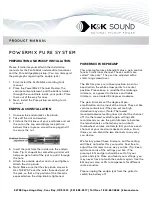
Model 3770
DC STRAIN GAGE PANEL METER
4.
CALIBRATION (cont.) – Shunt Calibration Equivalent Calculation
If
dead weight
calibration is not practical and the transducer calibration data is unknown, the
Equivalent Input
value for the factory-installed calibration resistor can be approximated as follows,
assuming that the mv/v sensitivity rating of the transducer and the bridge resistance is known.
X = 25000 x Rb
K x Rc
Where
X = Equivalent Input, % of full scale
Rb = bridge resistance, ohms
K = transducer sensitivity, mv/v full scale
Rc = calibration resistance, ohms (59 K installed)
Sample Calculation: Assume that K = 3.000 mv/v for a 5000-pound load cell (full scale) with a bridge
resistance of 350 ohms and using the internal 59K Ohm shunt resistor.
25000 x 350
59000 x 3
= 49.44% of full scale = 2472 pounds
When + CAL is depressed, input sensor is at zero, display is on the 5000 range, adjust the readout for 2472
Display Calibration
T
he 3770 instrument display has separate adjustment controls that are independent of the
analog controls which allow the user to alter the display reading to a value that is suited for the engineering units display
reading required. The additional span controls allow the user the flexibility to adjust the display reading as referenced to the
analog signal or referenced to the defaulted front panel display dip switches. In a standard – default “OFF” switch position
of the Coarse Span control, the display has a full scale reading set by the display range switches of 5000, 10000 or 20000
counts. At the selected reading the full scale analog output signal will be 5 VDC or 10 VDC, as selected by the Analog
Controls of the unit. To accomplish the display adjustment change, the user would first set the desired display range and
decimal location using the display dip switches, adjust - calibrate the analog output to the desired amplitude level and then
adjust the display Coarse and Fine span controls for the required digital readout.
Page 1
3
Tech Tip:
The inability to balance correctly where the unit output reads totally off scale and the zero controls have no
authority can very likely be the result of a damaged or defective transducer or cable. This possibility can be confirmed (or
eliminated) by substituting a transducer and cable known to be in good condition or by simulating a balanced transducer, using
either a commercially available transducer simulator or the simple
star bridge
arrangement shown below. The
star bridge
simulates a conventional four-arm bridge in an exact condition of balance. To construct a
star bridge
connect four resistors as
shown; use 180-ohm resistors to approximate a 350-ohm bridge.
Neither the resistor values nor temperature
characteristics are critical. Solder two
excitation resistors together, and then solder
the two Signal resistors together. Next, connect
the two junctions together using a separate
wire as shown. There is a good reason for this
method of construction, and it should be
followed. Connect the substitute or simulated
transducer to the module I/O connector using
a short 4-wire cable configuration as shown in
Figure 4. Attempt to balance the substitute or
simulated transducer. If conditions now appear
to be normal, the transducer or cable is at fault.
If the previous difficulties persist, the meter is
at fault.


































